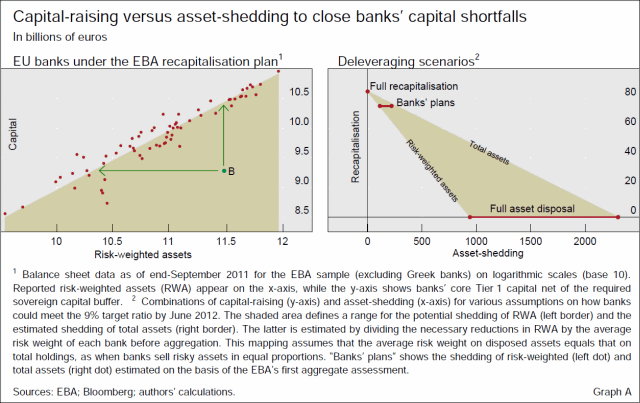Limited asset shedding among banks under the European recapitalisation plan
(Extract from page 7 of BIS Quarterly Review, March 2012)
The European Banking Authority (EBA) published its recommendation relating to the European bank recapitalisation plan on 8 December 2011. This forms part of a broader set of EU measures agreed in October 2011 to restore confidence in the banking sector. By the end of June 2012, 65 banks must reach a 9% ratio of core Tier 1 capital to risk-weighted assets (RWA). Capital will be assessed net of valuation losses on EEA sovereign exposures incurred by end-September 2011 ("sovereign buffer"). The 31 banks located in the shaded area below the regulatory line (capital = 0.09 RWA) in Graph A (left-hand panel) were below the 9% target ratio, as of end-September 2011, by an aggregate shortfall of €84.7 billion. The aggregate shortfall among all 71 banks in the EBA sample reaches €114.7 billion when six Greek banks are included with an estimated shortfall of €30 billion against the (stricter) capital targets under the EU/IMF financial assistance programme.
The plans banks submitted to regulators in January 2012 suggest that the shedding of bank assets will play a small part in reaching the target ratio. As the example of bank B in the left-hand panel illustrates, banks can deleverage either by recapitalising (moving upward) or by reducing RWA (moving leftward). The EBA's first assessment shows that banks intend to cover 96% of their original shortfalls by direct capital measures, although the proposed measures also surpass the original capital shortfall by 26%. Planned capital measures thus account for 77% of the overall effort, and comprise new capital and reserves (26%), conversion of hybrids and issuance of convertible bonds (28%), and retained earnings (16%), while the remaining 23% rely on RWA reductions, notably on internal model changes pre-agreed with regulators (9%) and on the shedding of assets (10%), comprising planned RWA cuts of €39 billion in loan portfolios and some €73 billion through asset sales.
In this regard, the European bank recapitalisation plan reduced, but did not eliminate, the need for banks with capital shortfalls to shed assets (Graph A, right-hand panel). The likely scale of asset-shedding cannot be inferred reliably from RWA reductions. However, assuming a 75% average risk weight on loans and that the average risk weight on disposed assets equals that on holdings (43%, from average RWA as a share of total assets, using Bloomberg data), the planned RWA cuts of €112 billion relating to lending cuts and asset sales (= €39 + €73 billion) translate into an estimated €221 billion reduction in total assets. Some of the lending cuts are an inevitable part of restructuring under state aid rules. While these amounts are sizeable, they are an order of magnitude smaller than if banks had sought to reach the target ratio without significant additions to their capital.

